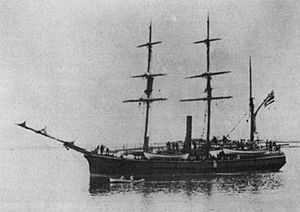Kaimiloa
 The Kaimiloa anchored at Honolulu. | |
| Career (Kingdom of Hawaii) | |
|---|---|
| Name: | HHMS Kaimiloa |
| Cost: | $20,000 |
| Commissioned: | 28 March 1887 |
| Decommissioned: | 30 August 1887 |
| Fate: | Burned in 1910 |
| General characteristics | |
| Class and type: | Explorer gunboat |
| Tons burthen: | 170 tons |
| Length: | 127 feet 8 inches (38.91 m) |
| Beam: | 25 feet 3 inches (7.70 m) |
| Draft: | 11 feet 2 inches (3.40 m) |
| Propulsion: | Wind-powered sails Steam engine (60hp) |
| Speed: | 8 knots (9.2 mph) |
| Complement: | 67 |
| Armament: | 4-inch cannons (4) Gatling guns (2) |
HHMS Kaimiloa was the first and only ship of the Hawaiian Royal Navy. The ship was a 170-ton Explorer gunboat, made in Britain in 1871. King Kalākaua bought the ship for 20,000 dollars and added the rigging.[1] It sailed from Hawaii to Samoa and other Pacific islands in 1887 in an effort by Kalākaua to form a confederation of Polynesian states to counteract European imperialism. The instance nearly resulted in military conflict between Hawaii and the German Empire who viewed Samoa as their possession in the Pacific. It was also used as a training ship. In the Hawaiian language, kaimiloa means "one who seeks afar".[2]
Voyage
The Kaimiloa came into commission on the 28th March 1887.[3] Twenty-four of the crew members were young Hawaiians who were enrolled in reform school, and who were placed on the ship's crew with only one month of training.[4] Due to the music program which was in effect at the reform school, some of these crew members were also members of a military band. They were led by Charles Palikapu Kaleikoa, who was a member of the Royal Hawaiian Band.[5] The ship's captain was George E. Gresley Jackson.[1]
Seeking an alliance with Samoa, the Kaimiloa set sail on May 18, and reached Apia on June 16.[4] However, due to Samoa already being in negotiations with the German empire, and the U.K. and U.S.A. also keeping track of the situation, talks did not progress well.[1] During these negotiations, the military band held a concert for the townspeople of Apia, which helped to build up good relations between them and the Hawaiians.[5] In addition, there were few problems caused by the crew, with only one incident that required reprimand being on record.[1][4]
Due to the effects of the coup d'état that happened in July 1887, the ship was ordered to return home on August 23.[6] They arrived in Honolulu on September 23.[1] This was the only voyage of the Kaimiloa for the Hawaiian navy. The crew were disbanded on August 29, and the ship was decommissioned on August 30.[7] After this, Charles Palikapu Kaleikoa reformed the Royal Hawaiian Band and continued to play in it until his retirement 40 years later.[5]
After decommissioning
After it was decommissioned, the Kaimiloa was still used as a quarantine ship, but in 1888 it was sold for 2,800 dollars[7] and used as a transportation vessel between the Hawaiian islands.[1]
In 1894 the Gatling guns were removed by the administration of the Republic of Hawaii.[7] Later, the steam engine was also removed and used by the sugar industry.[1] The Kaimiloa was then used to transport coal and oil.[7] In 1910 her hull was burned.[1]
References
| Wikimedia Commons has media related to Kaimiloa (ship, 1871). |
- ↑ 1.0 1.1 1.2 1.3 1.4 1.5 1.6 1.7 Logs of Kaimiloa & Velocity. Accessed on August 16, 2011.
- ↑ Helen Geracimos Chapin, "Shaping history: the role of newspapers in Hawai'i"
- ↑ Kaimiloa, March 28, 1887. Accessed on August 16, 2011.
- ↑ 4.0 4.1 4.2 Crew of the Kaimiloa, March 28, 1887. Accessed on 16 August 2011.
- ↑ 5.0 5.1 5.2 Kaimiloa Cadet Band. Accessed on August 16, 2011.
- ↑ Several of the crew members remained in Samoa after this. Pasefika Designs, LLC.. Accessed on August 16, 2011.
- ↑ 7.0 7.1 7.2 7.3 Bob Krauss Research Index (search for "Kaimiloa"). Accessed on August 16, 2011.